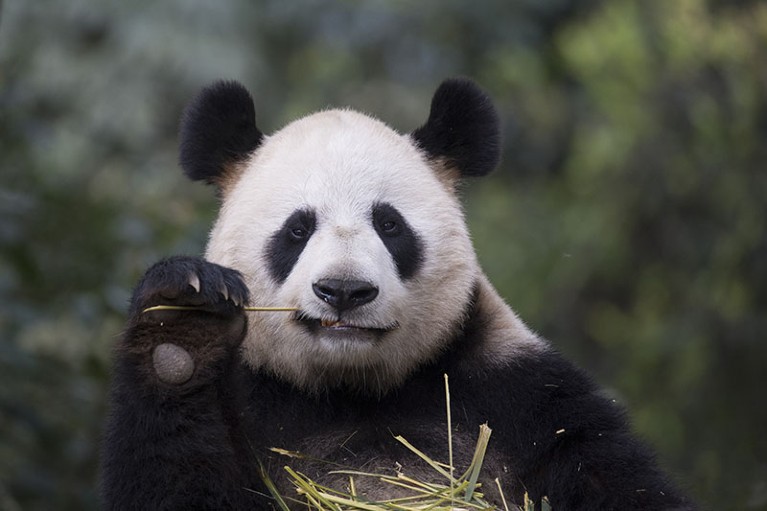The Giant Pandas Have Continued to Evolve for Three Million Years

Giant pandas weren't always on a strict diet of bamboo. Credit: Suzi Eszterhas/Minden Pictures
Giant pandas haven't been on their bamboo diet for nearly as long as scientists thought. Research suggested that the bears made the switch to bamboo millions of years ago, but a study1 now challenges this idea, proposing that the iconic creature went on its restrictive diet much more recently.
The paper, published on 31 January in Current Biology, reveals that giant pandas (Ailuropoda melanoleuca) started feeding on bamboo exclusively around 5,000 to 7,000 years ago. This suggests that before then, the pandas' diet and habitat were much more complex and varied than researchers thought.
The revised timing is a striking contrast to what others have proposed, says zoologist Huabin Zhao of Wuhan University in China. "I am so happy to see this new work coming out."
Zhao's own work has supported the view that giant pandas spent millions of years as bamboo specialists. Genetic data from a study2 he co-authored in 2010 showed that the animals lost the ability to taste umami — a savoury flavour associated with foods such as meat — about 4 million years ago.
And in 2007, palaeontologists described3 the 2-million-year-old skull of an ancient panda that once roamed southern China. The bear had powerful teeth and jaws that would have helped it to crush and grind fibrous plants, indicating a bamboo-centred diet, according to the researchers.
Variety is the spice of life
But pandas weren't always the recluses of bamboo forests that they are today, says Fuwen Wei, a conservation biologist at the Chinese Academy of Sciences Institute of Zoology in Beijing, and a co-author of the latest study. They used to live in more variable habitats, and consequently had a more diverse diet, he says.
To help pin down the timing of this dietary switch, Wei and his colleagues analysed ratios of stable isotopes, forms of chemical elements that don't decay over time, in the bones and teeth of ancient and modern pandas.
Stable isotope analysis can help scientists to reconstruct past diets and environments. When organisms eat meat or plants, the chemical signature of that food gets incorporated in their bodies. By sampling different tissues, scientists can get snapshots of what the animals consumed at different points in their life. Stable isotopes in the bones can reveal a general picture of what a creature devoured for the last several years of its life, whereas tooth samples yield information on what it ate during its early years, when the enamel formed.
Wei and his team measured isotopes in the bones and teeth of pandas that lived at least 5,000 years ago. They then compared the results with the isotope signals in wild giant pandas that had died between the 1970s and the 2000s, to try to understand how the species' diet had changed.
The findings strongly suggest that unlike the pandas of today, the bears' ancestors had a varied diet, probably as a result of living in a more complex environment such as a tropical-like forest.
On the menu
"This is the first account that I'm aware of that has looked this deeply into the diet history and evolution of pandas," says Jack Hopkins, a wildlife ecologist at the University of Ljubljana in Slovenia. But the analysis doesn't say what ancient pandas ate — only that it was different from what their descendants currently consume.
"I wanna know what's on the menu," says Alexis Mychajliw, a palaeoecologist at La Brea Tar Pits and Museum in Los Angeles, California. Such detailed information would require knowing what types of plant or animal ended up in the stomach of extinct pandas.
But that's no easy task, says Mychajliw, because potential panda foods from the past are hard to find in the fossil record. Still, studies such as this could provide clues as to what pushed giant pandas to their bamboo-only diet and why their ecological niche shrank so much, she says.
Insights into ancient panda habitats could also help to preserve modern populations. "If we know what kinds of changes have reduced the habitat of giant pandas, [we could] create better conservation strategies," Zhao says.
Mychajliw agrees. "As we think of conserving species in the future, I find it really exciting when people look to the past."
References
-
Han, H. et al. Curr. Biol. https://doi.org/10.1016/j.cub.2018.12.051 (2019).
-
Zhao, H., Yang, J.-R., Xu, H. & Zhang, J. Mol. Biol. Evol. 27, 2669–2673 (2010).
-
Jin, C. et al. Proc. Natl Acad. Sci. USA 104, 10932–10937 (2007).
Source: https://www.nature.com/articles/d41586-019-00301-y
0 Response to "The Giant Pandas Have Continued to Evolve for Three Million Years"
Post a Comment